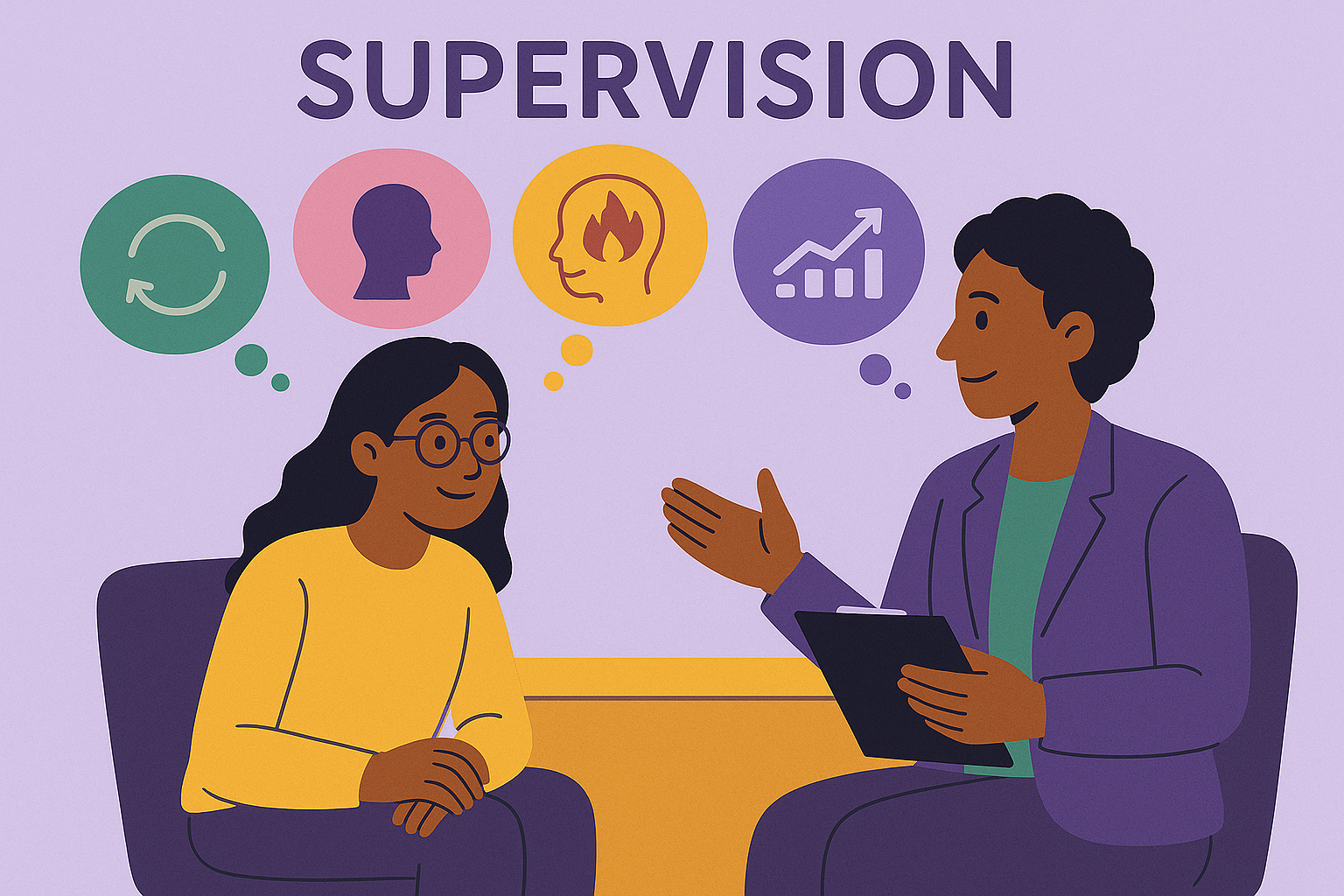Supervision 101: What Every Early-Career Therapist Should Know

Supervision is one of the most valuable aspects of a therapist’s professional journey. For early-career therapists, it can feel unclear: What exactly happens in supervision? How is it different from therapy? How do you even find the “right” supervisor, and what do you talk about once you do?
In this blog post, we’ll take a closer look at what supervision really is and why it’s essential for your growth as a practitioner. We’ll explore how to identify a supervisor who aligns with your professional goals, what topics to bring into your sessions, and how to structure supervision so that it’s not just need-based but also purposeful and progressive. We’ll also discuss how to track your development over time, ensuring that supervision supports both your confidence and competence.
Understanding Supervision: What It Is and What It Isn’t
Before we explore how to find an ideal supervisor and why supervision matters, it’s important to first understand what supervision really is.
Supervision is a space where therapists reflect on their therapeutic work, receive guidance, and develop professional skills. Seeking regular supervision in the first few years of private practice is extremely important. However, many early-career therapists often confuse supervision with therapy, and while they may overlap at times, they serve different purposes.
The boundary between therapy and supervision can feel thin. In supervision, it’s natural to discuss personal emotions, but the focus stays on how these emotions impact your work with clients. For instance, if you’re finding it hard to maintain objectivity or notice countertransference creeping in, that’s an important topic for supervision. But if an issue is primarily affecting your personal life or stems from unresolved childhood trauma, it’s best addressed in therapy rather than supervision.
In essence, supervision helps you understand how personal factors influence your clinical practice, while therapy supports your own personal healing and growth. Both are valuable as they just have different goals and boundaries.
Supervisor–Therapist Fit — Finding the Right Match
Finding the ideal supervisor can feel overwhelming, especially for early-career therapists who may not have a clear roadmap. Supervision isn’t just about guidance; it’s about finding someone whose expertise, values, and way of working align with your own professional journey.
You can choose a supervisor based on several factors:
- Therapeutic approach or perspective — Do they practice or understand the modality you wish to develop (CBT, psychodynamic, humanistic, narrative, etc.)?
- Experience and clinical background — Have they handled cases similar to those you’re likely to see?
- Identity and sociocultural lens — Do they understand the nuances of the cultural context or the communities you serve? Are they sensitive to the challenges of marginalized communities?
- Professional stance on ethical and legal issues — Can they confidently guide you through sensitive areas such as suicide risk, self-harm, child sexual abuse, or domestic violence cases? Are they also aware of the legal implications in such situations?
An ideal supervisor is not just knowledgeable but also approachable, supportive, and committed to your growth. They challenge you when necessary, but also create a safe space for reflection and vulnerability. During the early years of your practice, this guidance can be invaluable in shaping your therapeutic skills, ethical decision-making, and professional confidence.
Reflective prompts:
- What kind of therapist do I want to become, and who can help me grow in that direction?
- Do I feel safe discussing my doubts, mistakes, and vulnerabilities with this person?
- Does this supervisor model the kind of professionalism, ethics, and compassion I aspire to embody?
- Are their values aligned with the kind of impact I want to make in my practice?
By asking yourself these questions, you not only find a supervisor who fits but also clarify what matters most in your own development as a therapist.
What to Discuss in Supervision
Many early-career therapists carry the misconception that supervision is only for resolving client-specific concerns — “If I have an issue with a client, I’ll bring it up and move on.” While client work is indeed an important part of supervision, it is much more than that. Supervision is a reflective space to examine therapy challenges, ethical dilemmas, transference and countertransference, burnout, and even the practical realities of sustaining a therapeutic practice.
It’s also about checking in with yourself: If I’ve chosen to be in supervision, how am I engaging with it? Am I trusting the process, learning from it, and applying it meaningfully to my practice?
Raah’s Founder, Prerna Yadav, shares her own journey: in her early years, she focused solely on client-related questions in supervision, which made her overly dependent on her supervisor for answers. Over time, she realized that supervision could be far richer when structured intentionally. Instead of only bringing immediate client issues, she began noting:
- The challenges she faced repeatedly in her sessions.
- Situations that triggered discomfort or uncertainty.
- The times and contexts where she felt emotionally or mentally drained.
- Moments of transference and countertransference that influenced her work.
This shift transformed her supervision experience from problem-solving into professional growth. Rather than seeking solutions for every difficulty, she began understanding patterns in her work, which helped her become more confident and self-reliant.
Today, she encourages supervisees to use supervision as a space to:
- Reflect on recurring themes in their cases rather than isolated incidents.
- Explore personal reactions that affect their clinical judgment.
- Identify skill gaps or areas where they feel unprepared, and seek guidance proactively.
- Process ethical and emotional dilemmas that extend beyond individual cases.
By bringing both client-related issues and self-reflective insights, you maximize your learning and empower yourself to handle future challenges independently, a key step toward becoming a grounded and ethical therapist.
How Often Should You Schedule Supervision?
Supervision works best when it’s consistent rather than reactive. Many early-career therapists schedule sessions only when they feel stuck with a client. While that might solve an immediate problem, it misses the bigger picture: supervision is about growth, not just troubleshooting.
Scheduling sessions consistently, weekly, fortnightly or monthly, creates space for reflection, planning, and deeper learning. This consistency helps you track your professional development over time, rather than jumping from one crisis to the next.
Supervision isn’t just a space to “talk about clients” rather it’s an ongoing map of your journey as a therapist. To make the most of it, use it to set specific learning goals, reflect on your growth, and track skills over time.
Supervision at Raah:
At Raah, supervision is designed to support psychologists in the early stages of their careers (0–4 years of experience), whether they are employed at an organization or building their own private practice.
Who We Work With
- Preferred client profile of clients: Therapists working with adolescents and adults (13–60 years)
- Common presenting issues: Academic or career concerns, gender and sexuality, interpersonal relationships, violence, self-harm, suicide risk, depression, and anxiety
How Supervision Works at Raah
- Format: One-on-one sessions hosted online via Google Meet
- Frequency: Weekly, fortnightly, or monthly—tailored to the therapist’s needs
- Duration: Each session is 1 hour
Additional support:
- Curated resources after every session (books, manuals, video lectures, articles, blogs)
- Telephonic support between sessions for crisis situations (suicide attempts, self-harm, abuse, or violence)
- Access to group training programs for skill-building
- Networking opportunities to connect with therapists across India
What you can discuss in a Supervision session
- Knowledge and skill gaps, Case Conceptualization
- Transference and Counter-transference
- Crisis situations and ethical dilemmas
- Burnout and work pressure
- Ways to expand private practice
- Ways to diversifying skills in the mental health: content creation, facilitation of workshops and trainings
Therapeutic Approach
Theoretically, Prerna aligns with Humanistic Approach, Narrative Therapy, Dialectical Behaviour Therapy. She is also trained in Gottman’s Method Couple Therapy. Having said this, her work is not deeply rooted in theory, as she focuses more on the psychosocial context and its influence on mental health. She adapts skills of body based regulation and self compassion in her work. She is trauma informed, queer affirmative and is sensitive to the unique mental health challenges of marginalized communities.
If you are a therapist with 0-4 years of experience and are looking for a Supervisor, visit the ‘Supervision’ Page on the website for more details, and Connect with us today!

Misha Gada
I’m Misha Gada, a 22-year-old Counseling Psychologist driven by a passion for mental well-being and breaking the stigma around mental health. I aspire to work with couples and adults, helping them navigate challenges and embrace their unique experiences; while also exploring and supporting individuals from diverse backgrounds. When I’m not creating inclusive therapeutic spaces, you’ll find me lost in a good book, experimenting in the kitchen, or discovering cozy cafes—coffee in hand, of course!
Related Blogs
No related blogs available.
